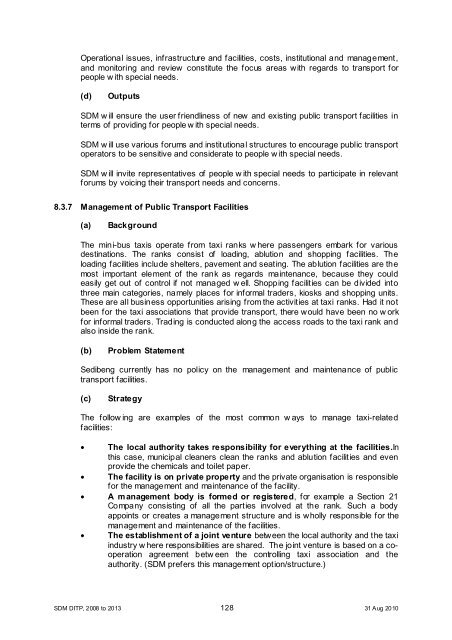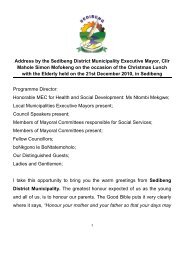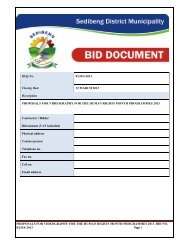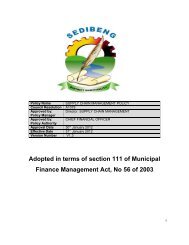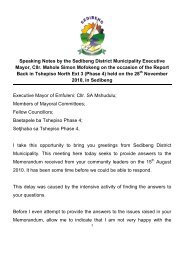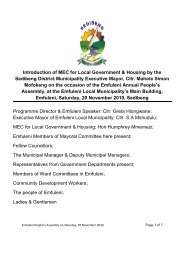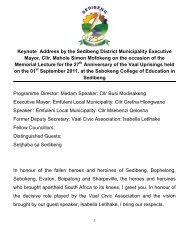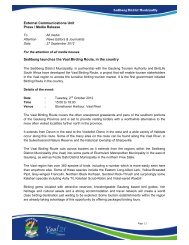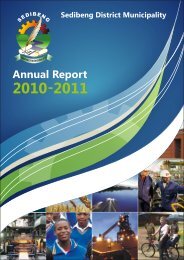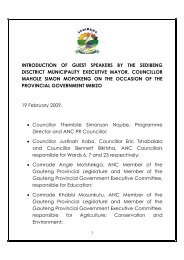Chapter 11 - Sedibeng District Municipality
Chapter 11 - Sedibeng District Municipality
Chapter 11 - Sedibeng District Municipality
Create successful ePaper yourself
Turn your PDF publications into a flip-book with our unique Google optimized e-Paper software.
Operational issues, infrastructure and facilities, costs, institutional and management,<br />
and monitoring and review constitute the focus areas with regards to transport for<br />
people w ith special needs.<br />
(d)<br />
Outputs<br />
SDM w ill ensure the user friendliness of new and existing public transport facilities in<br />
terms of providing for people w ith special needs.<br />
SDM w ill use various forums and institutional structures to encourage public transport<br />
operators to be sensitive and considerate to people w ith special needs.<br />
SDM w ill invite representatives of people w ith special needs to participate in relevant<br />
forums by voicing their transport needs and concerns.<br />
8.3.7 Management of Public Transport Facilities<br />
(a)<br />
Background<br />
The mini-bus taxis operate from taxi ranks w here passengers embark for various<br />
destinations. The ranks consist of loading, ablution and shopping facilities. The<br />
loading facilities include shelters, pavement and seating. The ablution facilities are the<br />
most important element of the rank as regards maintenance, because they could<br />
easily get out of control if not managed w ell. Shopping facilities can be divided into<br />
three main categories, namely places for informal traders, kiosks and shopping units.<br />
These are all business opportunities arising from the activities at taxi ranks. Had it not<br />
been for the taxi associations that provide transport, there would have been no w ork<br />
for informal traders. Trading is conducted along the access roads to the taxi rank and<br />
also inside the rank.<br />
(b)<br />
Problem Statement<br />
<strong>Sedibeng</strong> currently has no policy on the management and maintenance of public<br />
transport facilities.<br />
(c)<br />
Strategy<br />
The follow ing are examples of the most common w ays to manage taxi-related<br />
facilities:<br />
• The local authority takes responsibility for everything at the facilities.In<br />
this case, municipal cleaners clean the ranks and ablution facilities and even<br />
provide the chemicals and toilet paper.<br />
• The facility is on private property and the private organisation is responsible<br />
for the management and maintenance of the facility.<br />
• A management body is formed or registered, for example a Section 21<br />
Company consisting of all the parties involved at the rank. Such a body<br />
appoints or creates a management structure and is wholly responsible for the<br />
management and maintenance of the facilities.<br />
• The establishment of a joint venture between the local authority and the taxi<br />
industry w here responsibilities are shared. The joint venture is based on a cooperation<br />
agreement betw een the controlling taxi association and the<br />
authority. (SDM prefers this management option/structure.)<br />
SDM DITP, 2008 to 2013 128 31 Aug 2010


